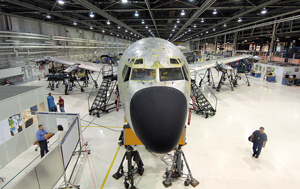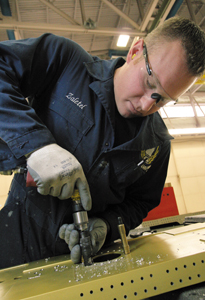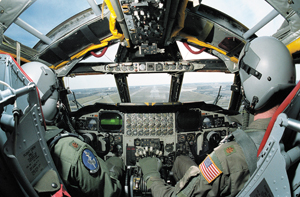Beset by the manifold problems of an old fleet, the Air Force has launched a pilot maintenance program that USAF logistics officials hope will dramatically transform the way the service keeps up its air vehicles and systems.
The effort has been dubbed High Velocity Maintenance, or HVM. It is part of a broader campaign within USAF’s air logistics centers to cut the amount of time that aircraft spend parked at depots undergoing overhaul and repairs.
A KC-135 undergoes depot maintenance at Tinker AFB, Okla.

The Air Force has started out small—with one special operations C-130 Hercules at Warner Robins Air Logistics Center, Ga. Even so, Air Force officials have high expectations for the overall effort.
Debra K. Walker, who is the Air Force’s acting assistant secretary for installations, environment, and logistics, claimed, “It’s going to completely revolutionize the way we perform overhaul on our airplanes.”
The HVM concept emerged from the US commercial sector, as have many recent initiatives to streamline depot maintenance. The idea is to bring aircraft to air logistics centers on a more frequent basis but for shorter periods. Rather than overhaul the entire airframe, the theory goes, maintainers would service parts of the aircraft in a sequential fashion. Under this plan, aircraft would enter a depot once every 18 months or so instead of once every five to six years.
For the C-130, every 18 months the aircraft would go into the depot for 12 to 15 days, rather than the 160 days the cargo aircraft now sit at the depots.
In addition to reducing an airplane’s out-of-service time, the more frequent checkups would give Air Force maintainers better insight into the effects of heavy usage on the fleet. This should decrease the number of surprises that have become common occurrences after nearly two decades on a war footing.
While the details of the program are still being hashed out, Walker indicated that the Air Force could also do inspections and most phased maintenance at the depots while maintainers conduct the periodic repairs.
“So that’s going to take the work off the flight line, allow them to focus on sortie generation, not focus on inspections and repair,” Walker said.
Operational statistics bear out the importance of sortie generation for today’s Air Force. In 2008, USAF flew some 61,000 sorties over Iraq and another 37,000 sorties over Afghanistan. That works out to about 265 sorties per day, said Gen. Norton A. Schwartz, the Air Force Chief of Staff, in May 21 remarks to the Senate Armed Services Committee.
In testimony this year, Schwartz and Michael B. Donley, the Secretary of the Air Force, noted that the service’s aged fleet requires “focused attention.” Indeed, the Air Force over the past two years has grounded large numbers of F-15 and F-16 fighters, A-10 attack aircraft, C-130 transports, and T-6 trainers, not to mention having experienced problems with C-5 transports and KC-135 aerial tankers.
The two top USAF officials asserted, “The skill and determination of our maintainers have ensured that we return aircraft to service as quickly as possible, but two percent of the fleet remains grounded and many aircraft fly restricted profiles.”
Problems enveloping Air Force special operations force aircraft probably are the most serious, but operational wear and tear is widespread. Even the workhorse C-17, a relatively new aircraft that is still in production, is seeing problems earlier than anticipated.
Wing cracks grounded some 130 A-10s—more than one-third of the fleet—last year.
For all that, the Air Force in recent years has seen a marked decrease in depot “flow days.” Heavy investments in advanced depot facilities and equipment since 2004, combined with process improvements, have contributed to more streamlined and efficient air logistics centers.
Initiatives include formal training programs to develop more skilled technicians and managers, benchmarking programs to identify industry leaders in various production processes, and making so-called “lean” business practices the norm.
The Air Force must continue to develop new ways to seek greater efficiencies out of its depots, according to the US Air Force Depot Maintenance Strategic Plan, issued in April 2008.
“Our success is contingent upon the ability of our people and organizations to adopt new, relevant operational concepts and processes, suitable to the dynamics of an integrated strategic enterprise,” according to the strategy. “To succeed, the [Air Force] must continuously validate and update our strategy across the ends, means, ways, and risk framework.”
The HVM concept amounts to an outgrowth of those previous efforts, as well as a reaction to both the constant use of the airframes and the heightened age of the aircraft. The average age of an aircraft in USAF’s total fleet is now 24 years—the highest in service history. The average age is expected to grow to 26.5 years by 2012, projects Air Force Materiel Command.
If all goes as planned, the HVM program will do much to prevent problems such as one that Walker witnessed on a recent trip to Warner Robins ALC. There, a C-5B in the hangar had not been to the depot in six years. Its overhaul was supposed to take 50,000 hours of work, but, because of unexpected problems, the program quickly grew to require 70,000 hours of work.
“That is significant and the reason why is [because the depot] hadn’t seen that airplane in six years,” Walker said. “So you want to continuously look at that airplane. You want that engineering assessment. You want the feedback from the field as to what’s happening in it, and look at it and catch it before it becomes a big, difficult problem—before it becomes a grounding situation.”
The Air Force first started down the path to HVM in Fiscal 2007, when officials outlined the concept in a paper. To flesh out the concept, the Air Force that year established a team comprising experts at Warner Robins and representatives from Air Force Special Operations Command. By the end of 2007, the team had twice briefed senior Air Force officials.
 |
SSgt. Albert Zaletel works on the closure beam of an F-16 at Hill AFB, Utah. |
Testing the Concept
“Since that time, the [high performance team] has been identifying lean events and projects required to implement an HVM proof of concept prototype,” according to an Air Force fact sheet on the effort.
Now begins the test of the concept itself. “We’re going to see if we have the right data, if we can develop the right repairs, if we can get the parts support,” Walker said.
For the pilot program, Warner Robins officials will go through the airplane and determine the parts that are needed and if the concept itself works. If successful, the Air Force will put a “couple more” C-130s through HVM within the next year, in the hopes of being at “full blown” in October 2010, Walker said.
Air Force Special Operations Command, Walker said, has been “very supportive” because it has a low-density, high-demand fleet. In short, special operators don’t need airplanes at the depot—they need them out in the field.
If successful, the results would be tangible. According to the Air Force, a successful HVM program would return 52 to 55 C-130s to their operational wings. Currently, there are typically 70 C-130s unavailable at any given time, so increased availability has almost the same effect as buying new aircraft.
The Air Force, meanwhile, has already designated another aircraft for HVM: the B-1B bomber, which has had its own share of maintenance woes. Last year, more than half of the fleet was down for some form of maintenance.
In April, senior officials from Air Force Materiel Command, Air Combat Command, and the Air Staff gave the HVM team at Tinker AFB, Okla., approval to proceed with a B-1 HVM pilot program. The team has developed a detailed schedule for the program, in the hopes of implementing it as early as next October.
In 2008, for example, the B-1 fleet averaged 28 aircraft available—with 36 “Bones” down for some type of maintenance at any given time. That rate is “unacceptable, and that’s why we’re doing HVM,” said Sam Malone, deputy director of the 427th Aircraft Sustainment Group at Tinker—the unit responsible for the B-1B fleet’s depot maintenance and repair work. “Our case for change is all the B-1s trapped in maintenance right now,” he added.
Unscheduled maintenance causes the biggest delays. The HVM processes are designed to “ensure the mechanic doesn’t have to wait,” he said. Some problems will be fixed right away, while others will be documented and deferred—helping maintainers fix the aircraft on their schedule, not that of the aircraft’s components.
Similar to the C-130’s HVM program, a B-1B would visit the depot for heavy maintenance four times in five years, with two light maintenance cycles performed in the field between visits.
It is unclear how many types of aircraft could benefit from shifting to the HVM process. But it appears, at least for now, that larger aircraft are best suited for HVM, Walker said.
Air Force officials expect implementing HVM to incur some costs, but they hope the program will ultimately generate overall savings—in addition to driving up aircraft availability rates.
Officials say the service most likely couldn’t have taken on new initiatives such as HVM without the increased investment in its depot facilities, equipment, and other capital needs over the last five years.
Prior to Fiscal 2004, the level of capital investment—excluding maintenance and repair costs—averaged just three percent of revenue, or about $140 million annually.
Based on the commercial benchmark of six percent, the Air Force funded an additional $150 million a year starting in 2004. The plan initially was to continue that level of funding just through Fiscal 2009, but Congress intervened and, in Fiscal 2007, required the Air Force to maintain that level of investment indefinitely.
“I think it’s phenomenal,” Walker said. “It allows [the depots] to be much more efficient. And, obviously, if we can increase the throughput, you can take down the cost and increase aircraft availability. To me, that’s the responsibility of the Air Force depot.”
AFMC has a “fairly robust process in place” to evaluate the return on investment—not just in financial terms, but also in terms of warfighter support, she said. The six percent investment, she added, seems like the right amount to put into the depots annually.
“I think that you need to ensure you’re buying the right things with that six percent,” she said. “I don’t think it’s too much if you’re making the right investment in the right place.”
“By embedding these initiatives into the maintenance culture, reductions are being made in shop flow days and cost,” according to the Air Force’s Fiscal 2010 budget documents.
Over the last five years, the Oklahoma Air Logistics Center at Tinker reduced programmed depot maintenance flow days for the B-1 bomber by 30 days, or 18 percent.
Ogden Air Logistics Center officials at Hill AFB, Utah, meanwhile, reduced the A-10 wing, F-16 wing, and F-16 stabilizer repair flow days by 39 percent. On-time delivery for A-10 wings is now 100 percent, and only slightly less—98 percent—for F-16 wings.
On the C-5 Galaxy, which is worked on at Warner Robins ALC at Robins AFB, Ga., the Air Force has reduced overhaul flow days by 103 days, or 31 percent. Doing so has freed up floor space for additional workload at the depot.
Meanwhile, the Air Force is working to decrease the flow days on its Eisenhower-era KC-135 tanker fleet to 120 days, Walker said. That would represent a 40 percent reduction—those aircraft now spend close to 200 days in depot.
Despite the recently improved efficiency, Air Force depots still face serious future challenges. Perhaps none of those challenges has been documented as well as the service’s efforts to properly maintain its nuclear forces.
The Air Force is still working to correct problems with its handling of nuclear material—which, at least in part, involved depot work. Two general officers at Ogden were among the 15 senior Air Force officers disciplined in connection with the errant shipping of nuclear missile nose cone components to Taiwan in 2006.
 |
Maj. Tim Hines (l) and Maj. Cary Montgomery ferry a B-52 to Tinker Air Force Base for depot maintenance. The HVM program will begin with the C-130 and B-1, but other large aircraft are candidates. |
More To Do
Problems identified at Ogden included ineffective command oversight of depot maintenance, engineering activities, and material control of sensitive components, a failure to adequately address logistics policy deficiencies, and failure to correct issues with intercontinental ballistic missile logistics.
“Just this last weekend, we were back at Ogden Air Logistics Center reviewing the progress made there over the past year in the handling of nuclear-related materials,” Donley told a House panel in June. “They have made progress there, but there is more to do.”
Donley added that USAF does not yet have all the automated systems it needs to “help us with end-to-end accountability and get us out of the paper environment.”
As she looks at the state of the depots, Walker sees mostly positive signs. Still, she acknowledged, there are areas for improvement. The need to move away from mountains of paperwork isn’t exclusive to the nuclear fleet. “We still have too much paperwork,” she said, and this can hamper and slow down work at the depots.
The Air Force, Walker added, also needs to get its enterprise logistics and procurement system, the Expeditionary Combat Support System, deployed. Doing so would give logisticians new insight into deployed parts and other data.
“That is absolutely critical,” she said.
ECSS, which would replace 250 legacy logistics and procurement systems when it is fully operational in Fiscal 2013, provides a single, integrated logistics system that includes transportation, supply, maintenance and repair, and other key business information.
Walker also would like to see the air logistics centers more involved with the private sector during the development of software for weapons systems. Today, the depots have to replicate the equipment in order to maintain the software.
The Air Force also faces some challenges in its supply chain—particularly on spare parts obsolescence as aircraft get older.
Meanwhile, Walker said she hopes for continued investments in technologies for depots—including potentially, one day, equipment that could see through multiple substructures on an airplane to diagnose a problem without taking the aircraft apart.
But, perhaps most importantly, Walker stressed the need to continue assessing industry best practices for application in Air Force depots.
“You tend to, as you do AFSO21 and lean, you think, ‘I’m done. We’re good. We’re better than so-and-so,’” she said. “We’ll never be done. We can always get better.”
The stakes are too high for the Air Force depots to be satisfied with the progress so far.
“We continue to say, ‘What else can we do?’” said Walker, “because we need to meet a certain aircraft availability in the Air Force. We are a key component to that because every moment the airplane’s in the depot, it’s not in there helping us in the fight.”
